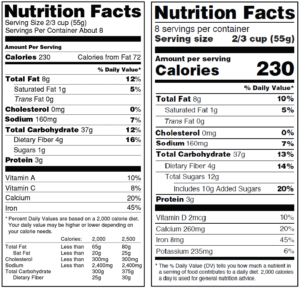Steps To Prepare for the New FDA Food Label
In May 2016, the FDA released its final rules for the updated food & beverage labels. These changes are revisions to the Nutritional Labeling and Education Act (NLEA) of 1990. Most producers will be required to adhere to the new rules within two years (2018), though producers that earn less than $10 million per year in revenue will have until 2019 to meet the changes.
The updates will have a major impact on food & beverage producers and their products. Some of the specific changes include:
- Changes in required nutritional information, such as a new added sugars declaration and changes to daily values and vitamins
- New record-keeping requirements
- Changes to serving sizes
Here are some things to put on your to-do list:
Keeping and documenting new records.
In addition to the new, mandatory declaration for added sugars, vitamin D and potassium declarations are mandatory. These changes will require producers to specifically calculate and track new totals in the food production process. For the first time, food & beverage processors are required to make and keep records that verify the declaration of mandatory nutrients, such as added sugars, certain dietary fibers, vitamin E, folic acid and folate, for which analytical methods are not currently available. Even though you have some time to actually implement these changes on your labels, getting a jump on calculating and tracking these records will make it easier to comply with the new label regulations.
Make appeals on trans fat now.
In June 2015, the FDA mandated that partially hydrogenated oils be removed from food production by June 18, 2018, essentially eliminating all artificial trans fat from food. However, trans fat is remaining on the new label format because dairy (“ruminant” or natural) sources can contribute to trans fat intake. In addition, the FDA is accepting petitions to allow some industrial trans fats in specific products. If you do not expect to be able to produce your goods without trace amounts of trans fat, now is the time to begin an appeal to the FDA.
Prepare for new label layouts, designs & costs
The FDA’s new rules include changes to the format of the Nutrition and Supplemental Facts Label (the principal display panel). Broadly, these changes include:
- Bigger type for all information
- Different information will be bolded
- New, required label formats for certain products, in accordance with changes to serving sizes
- Potentially more space for some brands
There’s a new, mandatory footnote at the end of the principal display panel, which replaces the old daily values footnote that appeared at the bottom of the panel. While this change doesn’t technically add any space to the panel, many food & beverage brands have (incorrectly) left off the previous daily values section for years. In reality, many brands will have larger labels because this footnote is smaller and the rest of the label is bigger. That means potentially limited branding space, new label design or even new printing plates and additional label printing costs. You’ll need to work with a label-printing partner to plan for these changes and find solutions to minimize the potential cost impact.
There is still an exception on the books, however, for packages that have 40 or fewer square inches of total packaging available for labeling. In these cases, facts may be placed on any label that may readily be seen by consumers and in a “side-by-side” format where necessary, with information following vitamins and minerals placed immediately to the right and separated by a line. Also, if the package does not have the necessary vertical space (about three inches) to accommodate the standard vertical layout, nutritional information may be presented horizontally. This exception remains in place from earlier FDA rulings, and more information on size restrictions can be found here.
Source: Foodprocessing.com




